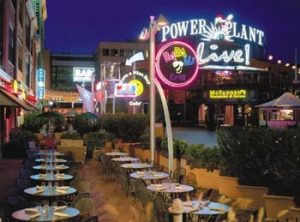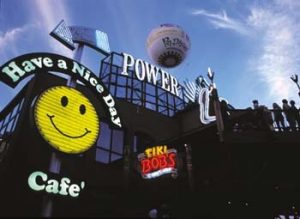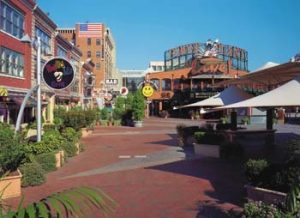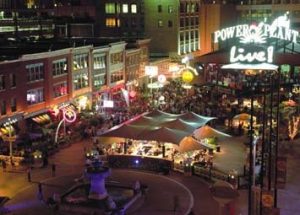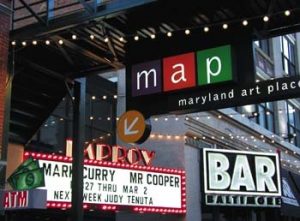Design
It’s Alive!
Baltimore’s newest attraction is full of life and light.
Published
18 years agoon
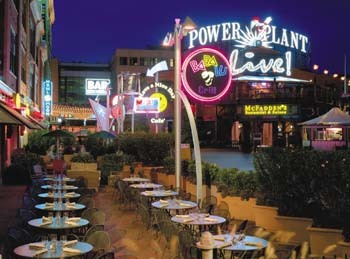
Made famous by Bobby Bare, and re-recorded by such artists as Graham Parsons, and the duo of Nanci Griffith and John Prine, Streets of Baltimore expresses a longing to return to a favorite place. Like the woman in the late 1960s song, many of Baltimore’s 13-million yearly visitors have discovered the hypnotic effect of Charm City’s scenic streets and city lights.
A city recognized for setting the urban-renewal standard, Baltimore has added yet another memorable attraction to its arsenal. Located two blocks from Inner Harbor, Baltimore’s "crown jewel," Power PlantLive! (PPL!) is becoming a choice entertainment destination for both tourists and locals.
Opened in phases in 2001 and 2002, PPL!, a $30-million redevelopment complex, occupies two, previously vacated, city-square blocks, and comprises a collection of 15 entertainment venues, including restaurants, clubs and retail shops. An open-air plaza and loft offices add to the new entertainment district’s charismatic appeal.
Over the years, PPL!’s location had proven commercially disadvantageous. In 1981, the Brokerage, a former entertainment venue, was developed in the same location. However, the Brokerage’s popularity was short lived, and the 30,000-sq.-ft. facility eventually closed.
Six Flags Power Plant, another venue nearby, closed in 1989. However, in 1999, the Cordish Company, a Baltimore-based, real-estate developer, conceived the Power Plant — a sister entertainment venue located within two blocks of PPL!. Power Plant’s continued popularity has facilitated the task of bringing new entertainment facilities and restaurants to Baltimore’s waterfront.
Due to its success with the Power Plant, the Cordish Company applied to develop PPL! and was awarded the job. According to David Cordish, chairman of the development company, the project was "a golden opportunity" that complemented the company’s 30-year, entertainment-development experience.
To assist with the project’s development, the Cordish Company hired Baltimore-based Brown & Craig Inc., a full-service design firm that offers architectural, interior-design and graphic-design services. According to Brown & Craig President and CEO Bryce Turner — who worked closely with Brown & Craig project designer Earl Sipes — the Cordish Company was impressed with the firm’s urban-renovation experience.
Turner recalled, "The Cordish Company became aware of our urban-renovation projects — for which we provided new signage and storefronts — throughout Baltimore and other East Coast cities. Our role with Power PlantLive! was to serve as primary design professional and oversee the project’s architectural, graphics, engineering and interior-design components. Not only did we develop the project’s graphics and signage, we designed several restaurant and club interiors."
Bringing PPL! to life
Dressing up PPL!’s open-air plaza, and developing unique storefronts that would be visible from the plaza area, rated as Brown & Craig’s primary project goals.
"Each new tenant was to have its own front door that could be accessed from the plaza area," Turner explained. "Thus, one of our goals was to ensure that every storefront was unique and clearly visible from the plaza. We allowed tenants the freedom to express themselves via fascia and projecting signs."
In addition, Brown & Craig determined the best way to draw attention to the new entertainment venue. At first, team members considered lasers, as well as overhead trams and street cars for easy accessibility. However, they eventually opted to erect two, neon, rooftop signs (the venue’s largest sign components) onto a central building’s front and north sides to attract the attention of pedestrians more than two blocks away and drivers on Interstate 83.
The sign on the front side of the central building (facing the open-air plaza) features a 15-ft.-tall "lightning bolt" figure and 7-ft.-tall "Power PlantLive!" letters. The sign on the building’s north side (facing I-83) comprises 8 to 11-in.-tall letters that span approximately 115 ft.
Although the project posed no stringent design limitations, Turner said Baltimore’s Design Advisory Panel (DAP), which has jurisdiction over all significant downtown projects, inspired the Brown & Craig design team to pursue high-quality, 3-D elements. According to Turner, DAP continually seeks the best possible design components for Downtown Baltimore.
Further, due to the historic nature of the area’s buildings, sign placement was restricted to designated areas. Plus, storefront graphics had to reflect an historical context and receive the Maryland Historic Trust’s approval.
However, on the whole, the city allowed the design firm to create some pretty aggressive sign components, because the area had remained vacant for so long, and there weren’t any proximate residential areas.
For example, the city granted Brown & Craig permission to incorporate cascading neon — a technique that hasn’t been used in Baltimore for a long time and reportedly doesn’t exist — to provide animation to the project’s "lightning bolt" rooftop sign.
Turner explained, "Most zoning regulations frown upon animated signs. As a result, we had to prove that, by mixing the cascading and static neon, we were creating a unique and cutting-edge sign, not something tacky. Due to the entertainment nature of the project, and the fact that it was an urban site, the city allowed us to incorporate this technique."
According to Turner, another primary design goal involved blurring the line between signage and architecture. In the case of Tiki Bob’s restaurant, the design team incorporated tikis and torches near the primary logo signage, making it difficult to determine whether such components are part of the building’s signage or architecture.
"We really focused on expanding the signage," Turner noted. "We worked hard to blur the line between where signage stopped and where building design began."
By amplifying the signage, Brown & Craig was able to create some flare and excitement, as well as maintain the "look" of tenants’ distinguishing logo signs.
Local flavor
Collaboratively, Brown & Craig, the Cordish Company and several PPL! tenants reviewed bids submitted by local sign fabricators, and they eventually selected five shops to produce the project’s signage. Turner explained that Brown & Craig grouped the job’s signage — which included two neon, roof-mounted signs; tenant signs in various sizes; 20-ft.-tall pylon structures; awnings; and wayfinding components — into five different packages and submitted them individually.
Although he recalled no major fabrication challenges, Turner noted that the central building’s structure had to be reinforced to accommodate the two neon roof signs.
He said, "We were dealing with a metal building behind a brick facade that incorporated light-gauge structural steel. We had to reinforce the existing building with heavier structural steel so it could support the signs."
Project sign fabricators incorporated such materials and techniques as aluminum, Plexiglas® acrylic, high-density urethane (HDU) foam and wood, and surface-mounted and open-channel neon lighting to create an array of graphic and vintage signs reminiscent of some of the oldest entertainment districts in the world, including Bourbon St. and Times Square.
Participating sign companies installed the components they fabricated and sought Brown & Craig’s assistance on an as-needed basis. Overall, the shops produced between 20 and 25 signs, as well as numerous fabric awning structures for PPL!.
As a result of its proven ability to stimulate pedestrian activity and appreciation, PPL! promises its hometown a bright and successful future.
Key Project Players
The following companies participated in PPL!’s construction. All businesses are based in Baltimore, unless otherwise noted.
Developer/Owner
The Cordish Company
(410) 752-5444
www.cordish.com
Architect/Designer
Brown & Craig Inc.
(410) 837-2727
www.brownandcraig.com
Sign Fabricators
Belsinger Sign Co.
(410) 837-2700
("Power PlantLive!" roof-mounted signs and tenant pylon structures)
GableSigns Inc.
(410) 255-6400
www.gablesigns.com
(Tenant signs in pylon structures; the plaza bar’s themed neon; "Tiki Bob’s" "McFadden’s" and "Bill
Bateman’s Bistro" tenant signs;
and "Babalu Grill" awnings.)
A & A Sign Co.
(410) 662-1100
("Havana Club" main-identity sign and "Babalu Grill" tenant signs)
Triangle Sign & Service Inc.
(410) 247-5300
("Bar Baltimore" tenant signs and awnings)
Network Sign Co.
(410) 625-0317
("Mondo Bondo" tenant signs and "Power PlantLive!" directional signs)
General Contractors
Chesapeake Contracting
Group Inc.
Reisterstown, MD
(410) 526-7797
www.chesapeakecontracting.com
("Shell Building" interior, office lobby, "Maryland Art Place")
Jeffrey Brown Construction
Towson, MD
(410) 339-5733
("Tiki Bob’s," "Bar Baltimore" and "Have a Nice Day Café")
Constantine Commercial
Construction
(410) 686-5300
www.ccconst.com
(Plaza bar)

SPONSORED VIDEO
Introducing the Sign Industry Podcast
The Sign Industry Podcast is a platform for every sign person out there — from the old-timers who bent neon and hand-lettered boats to those venturing into new technologies — we want to get their stories out for everyone to hear. Come join us and listen to stories, learn tricks or techniques, and get insights of what’s to come. We are the world’s second oldest profession. The folks who started the world’s oldest profession needed a sign.
You may like

Orbus Celebrates Earth Day With Recycling Achievements

American Sign Museum Names New Executive Director

3 Things Print Pros Must Do to Build Stronger Relationships in the Interiors Market
Subscribe

Bulletins
Get the most important news and business ideas from Signs of the Times magazine's news bulletin.
Most Popular
-

 Tip Sheet1 week ago
Tip Sheet1 week agoAlways Brand Yourself and Wear Fewer Hats — Two of April’s Sign Tips
-

 Photo Gallery2 days ago
Photo Gallery2 days ago30 Snapshots of the 2024 ISA Sign Expo
-

 Ask Signs of the Times4 days ago
Ask Signs of the Times4 days agoWhy Are Signs from Canva so Overloaded and Similar?
-

 Real Deal2 weeks ago
Real Deal2 weeks agoA Woman Sign Company Owner Confronts a Sexist Wholesaler
-

 Benchmarks7 days ago
Benchmarks7 days ago6 Sports Venue Signs Deserving a Standing Ovation
-

 Women in Signs2 weeks ago
Women in Signs2 weeks ago2024 Women in Signs: Megan Bradley
-

 Photo Gallery1 week ago
Photo Gallery1 week ago21 Larry Albright Plasma Globes, Crackle Tubes and More
-

 Women in Signs1 week ago
Women in Signs1 week ago2024 Women in Signs: Ashley Borell
